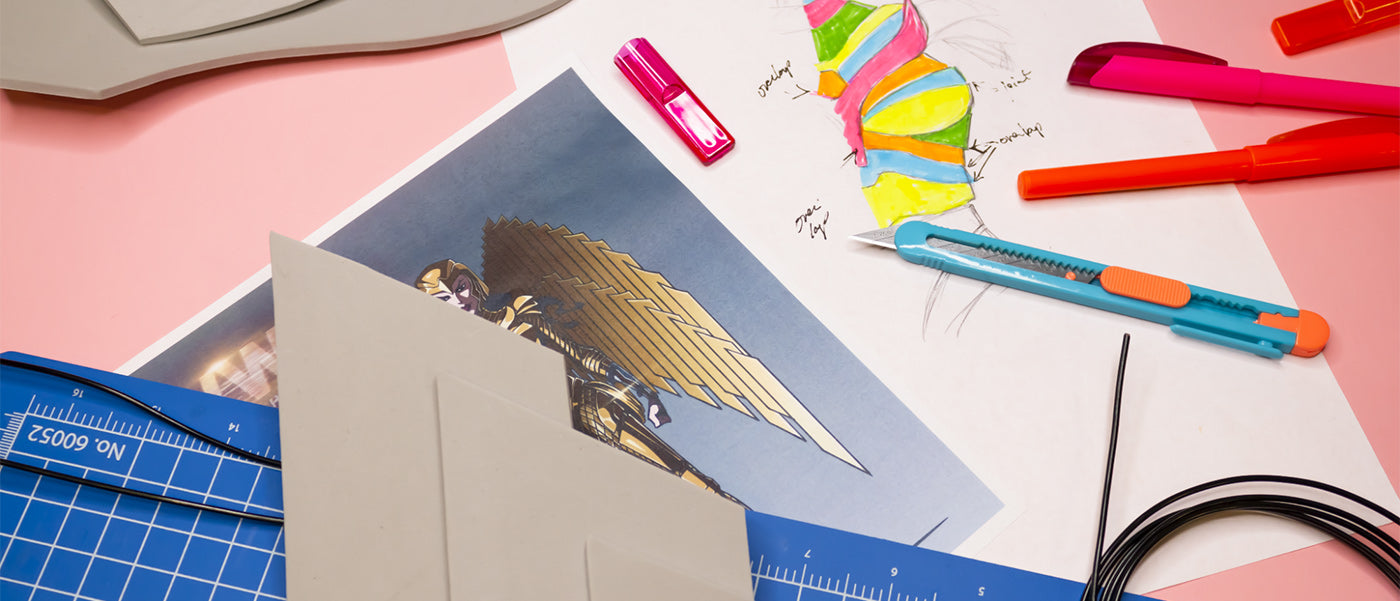
How to Make Cosplay Wings [with Video Tutorial]
When the cosplay character you chose has wings, the idea of creating this additional feature can seem overwhelming at first. But with a few strategically planned out steps, time and the right supplies a winged part of the costume can get done in time for the next Comic Con.
Just like with Cosplay Armor, gather reference images of the character’s wings you’ll be recreating. Sketch out the and highlight the parts of the wing that will be the base or the supporting parts and then using a different color, highlight the trim or decorative areas that will be glued or mounted on the support structure. This is to help plan out the steps for creating the wings.
Got the Right Tools? Check out Our Selection of Cosplay Tools

Wing Frames are Important
Bird’s wings have a frame made from strong and hollow bones. Bat wings are a marvel of nature’s engineering genius and butterfly wings are supported by a network of tubular veins. All wings have some sort of a structural frame - cosplay wings are no different.
Study your character and decide what type of frame will be the most appropriate. It can be a simple wire or wood frame or a complex PVC tube framework with moving and extendable parts.
Decide how small or large the wings will be. Size is a deciding factor which will dictate the frame’s construction, how they’ll be worn and the materials used to recreate the wings. The frame has to support the whole structure and its weight.
Wood is lightweight, but can also break easily. Wire is equally lightweight, bendable but may require additional tools and expertise when working with a thicker gage. PVC pipe is rigid, lightweight but is not pliable. Chicken wire or plastic mesh can also be considered as additional base material.
Plan out the frame
On a large piece of paper cut from a roll (you can also tape several sheets of printer paper together), draw the “center line” and outline the general shape of the wings. If wings are symmetrical, only work on the one side you can mirror everything for the opposite wing later.

For a simple wire frame, use a thicker wire gauge and shape along the outline using pliers. Start at the center-line and work your way around back to the center line. Glue the wire ends to a foam base. Reinforce the foam if needed.
For a heavier and more elaborate wing, put together a reinforced and sturdy center frame first, then lay out the interior skeletal network or either wire, pvc pipe or wooden dowels. To test your frame's integrity, pick it up while working on it, if it feels wobbly and loose, continue to improve the frame until it feels solid.
Consider where the shoulder straps will be attached and mark that on the frame. Reinforce those sections if needed. Depending on the size and weight of your character’s wings, you may need to use wide webbing, or pad the straps like on a hiking backpack.
Top tip: Consider the final look of the character and how the entire support structure will be covered and hidden from view when worn. You may need to plan the costume to accommodate a wing harness that’s worn under the costume and only the wings are visible.

Feathers and Scales
Mythical creatures usually borrow their feather look from birds, so these will be covered in feathers. If you’re creating butterfly wings or dragons wings, you’re in for creating hundreds, perhaps thousands of scales.
To cover your wings, you can do a few things: create a fabric pattern to sew over the frame and then attach the feathers or scales to that. This gives the wings a uniform base for feather or scale application. Simply glue them on starting from the bottom up creating an overlapping layer with each row. Cutting non stretchy fabric requires a precise pattern matching your frame's shape, so if you want a bit of wiggle room on the precision part, use a four-way stretch fabric. These stretchy fabrics generally take the shape of the frame or fill they’re pulled over, and are great to use on bat wings.
Another material great for cosplay wings is PVC vinyl. Because it’s a synthetic material, it’s available in an array of colors, transparent colors, textures and sheens. Check out the high-gloss of the iridescent transparent options! Very cool. Additionally, this material can be glued or sewn.
Rotary cutters are a must in a cosplayer’s tool box - check out our selection!

Cutting feathers or scales
Make templates of feathers or scales for your wings as you’ll be cutting many of them, even if you decide on a large scale size for them. This will help to maintain the general size of the feather or scale. Make a minimum of three slightly different shapes to mix for an organic look.
If you’re cutting felt or other soft fiber fabrics, use a good pair of scissors. For small and curved shapes, try Curved Lexan Scissors, these have a curved blade and can be easier to cut round shapes.

If you are cutting vinyl, use a hobby knife with a fresh blade - and don’t forget about the cutting mat. It will protect your blade, help it last longer and save your worktop from blade marks.
Use glue to apply the scales or feathers working your way from the bottom up. Layer and stagger so that they’re arranged in an organic manner, slightly uneven or imperfect is a good thing.
Add the finishing touches including the appropriate shoulder straps.
WATCH TUTORIAL HERE: Make your own Cosplay Wings - Excel Blades® DIY Tutorial